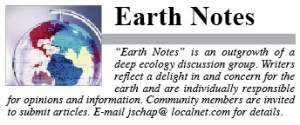Earth Notes: Too many people on Earth?
How many people on earth are too many? Most of us don’t even think about that question, and most politicians don’t dare to discuss it. Yet it urgently needs to be asked and a credible answer formulated, or else nature will answer it for us. If we choose that path, we definitely will not like nature’s response.
In his 2013 best-selling book, Countdown, Alan Weisman wrote, “In the entire history of biology, every species that outgrows its resource base suffers a population crash — a crash sometimes fatal to the entire species.†That isn’t theory; it’s fact — a fact abundantly documented in the biological record. Like all true laws of nature, there are no exceptions. If we overpopulate the carrying capacity of Earth’s environment, we will face a mass die-off. Period.
Our question no longer is: Are we reaching the limit of human population? The real question has become: How much further beyond the carrying capacity of the Earth can we go before human population crashes? We’ve become fools dancing on the edge of a cliff, blithely assuming we can’t fall.
Of course, the primary force that prevents us from addressing this existential question is religious teaching. Traditionalist religions — Judeo-Christian, Muslim, Hindu, and ancient tribal faiths — have imposed upon their followers strict prohibitions against population control, and have attempted to extend those prohibitions to human society as a whole. That’s why few politicians are willing even to raise the issue. It’s one of those “electrified third-rail†topics that they treat like poison, and their approach is to “let sleeping dogs lie.â€
Unfortunately, the dogs no longer are willing to lie. All over the earth the dogs of nature are growling: rising temperatures, melting glaciers, searing heat waves, uncontrollable forest fires, declining crop yields, catastrophic storms, and tidal waves of human migration. Every indicator suggests that we are seeing only the beginning of misery and disaster. Weisman wrote further, “Either we decide to manage our own numbers, to avoid a collision of every line on civilization’s graph — or nature will do it for us, in the form of famines, thirst, climate chaos, crashing ecosystems, opportunistic disease, and wars over dwindling resources that finally cut us down to size.†If all this sounds like the end of human civilization, that’s because it is.
The cause of our moral dilemma is clear. Religious prohibitions on population control were enacted by Bronze/Iron Age societies that faced exactly the opposite problem of what we face today. During those ancient times, there probably never were more than a couple of hundred million people living on earth, so religious leaders were trying to prevent human population from declining so much that their societies would be in jeopardy. Plagues, famines, wars and other disasters devastated populations again and again. Maintaining stable populations was a full-time job for our distant ancestors, so restraining population became anathema.
Over the centuries, what began as a grim necessity hardened into dogma set in concrete. So here we are today, facing a situation exactly opposite to that faced by ancient theologians. We are watching our world being devoured by too many people consuming too many irreplaceable resources. It’s our choice. Either we will move beyond traditional religious thinking to deal with our present overpopulation crisis, or we will allow nature to do it despite us. James Russell Lowell wrote, “New occasions teach new duties; time makes ancient good uncouth. They must upward still, and onward, who would keep abreast of truth.â€



